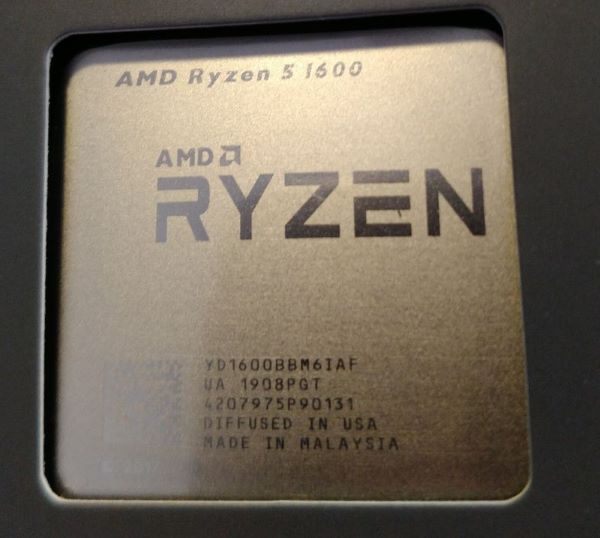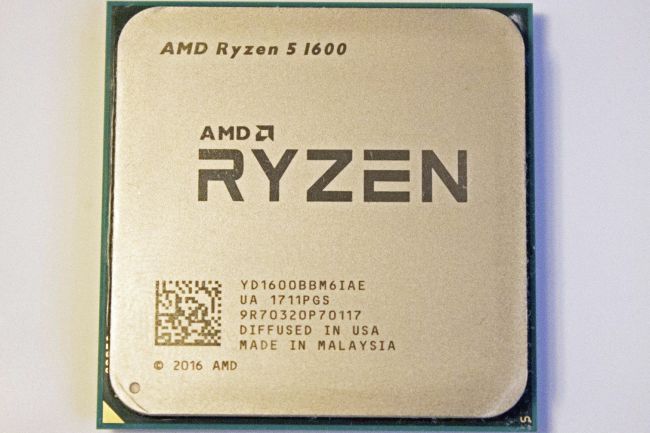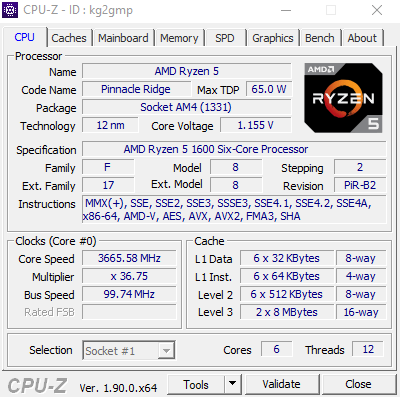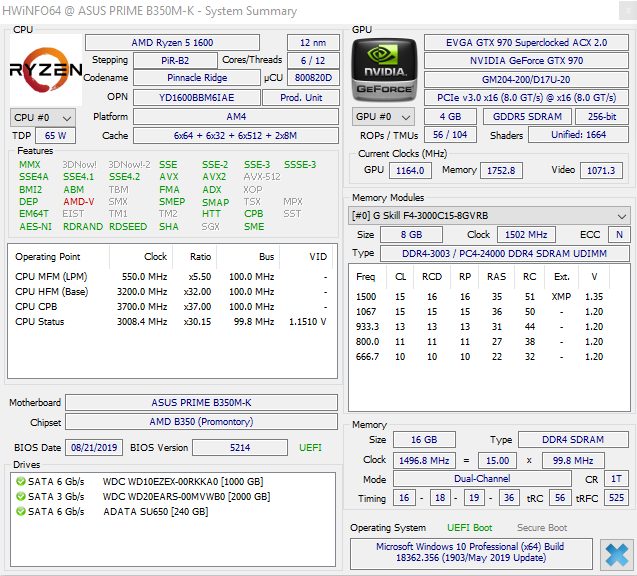That's Ryzen AF: Some Old AMD Chips Might Be Getting a 12nm Makeover
First-gen chips are popping up with AMD's second-gen 12nm "Zen+" Process

AMD's first-gen Ryzen processors are selling at all-time low pricing, but it turns out that some of these chips are filtering out into the hands of enthusiasts with an unexpected surprise: The 12nm process, which is more efficient and faster than the original manufacturing process used with AMD's freshman Ryzen chips.
The original Ryzen 5 1600 landed with six cores and twelve threads powered by the 14nm GlobalFoundries process, but a new "AF" version has appeared at retailers for a mere $85 and apparently comes with the 12nm Zen+ architecture.
AMD's second-gen Ryzen processors debuted with the new 12nm die, and while the new process didn't offer smaller transistors or a new grounds-up architecture, it did bring performance and efficiency gains compared to the original Ryzen's 14nm LPP process. AMD tweaked the Zen architecture, which it dubbed Zen+, to support higher frequencies, more sophisticated multi-core boost rates, and faster memory/caches that together yielded a ~3% increase in instruction per cycle (IPC) throughput.
All of these advances made the Ryzen 5 2600 a solid step forward over the 1600, and though it certainly isn't a given, it's logical to assume the AF versions of the Ryzen 5 1600 could benefit from some of those same advantages.
First, you need to look no further than the box, or the chip itself, to spot a new AF model. The original 14nm Ryzen 5 1600 models (released in 2017) come with the YD1600BBAEBOX product identifier, while the new models (released circa November 2019) come with the YD1600BBAFBOX part number.


As we can see in the picture above (posted by redditor u/_vogonpoetry to Imgur), the first line of code on the IHS of the processor now also ends in "AF" for the impacted parts. As you can see from the second image, which is of our original 1600 sample we received from AMD, the older version comes with "AE" at the end of the code.


The "AF" identifier was originally thought to classify the chips as two different steppings of the 14nm Zeppelin die (B1 and B2, respectively), but common test utilities, like CPU-Z and HWInfo, identify these chips as 12nm parts. There is a chance that this is merely a mistake in the product identifier strings programmed into the chips, but we've reached out to AMD for official comment and will update as necessary.
Get Tom's Hardware's best news and in-depth reviews, straight to your inbox.
Even though these chips come with the 12nm process, AMD has left the clock rates for the 1600 the same as before, so you don't get any top-line improvement there.
One redditor recently scored an AF model and put it to the test, noting:
"Interestingly this CPU boosts to 3.7GHz, 100MHz higher than the normal 3.6 boost which I thought was weird so I went back and checked the old AE chip and it too boosted up to a 37x multiplier, but only very briefly. Under any load, even 1-2 cores, the old chip fell to 3.4GHz. But this new AF chip was able to sustain 3.7 for longer periods which is only 200 MHz lower than the real 2600. The stock all-core boost algorithm is also much improved, still boosting to 3.6 GHz under cinebench load which is quite a bit higher than the 3.4 of the "AE" 1600. I expected to see only the 3% IPC gains of the Zen+, but the actual performance is much better, and it scores a full 400 pts higher in R20. In CPU-Z we can see 12nm listed and Pinnacle Ridge, matching the 2600. Memory Latency is reduced as well thanks to Zen+'s IMC.
Also interesting that Ryzen Master complained about the CPU being unsupported until I updated it. I was a few version out of date, but not that old... They must have had to add special support for this chip?"
Now, that certainly doesn't mean that all of these AF revision 1600's will offer these same advantages, but it does bode well for enthusiasts willing to spend what we would consider a paltry sum for the very capable AF version of the Ryzen 5 1600.
Naturally, we would expect the advantages of the faster process to crop up when overclocking, but from the redditors' experience, that is still very much up to the silicon lottery: The AF model wasn't able to hit the same overclocked clock speeds as the standard Ryzen 5 1600. The redditor also found they couldn't overclock the memory as effectively, but bear in mind that the lion's share of memory overclocking gains with the second-gen Ryzen models came from improvements made to trace routing on motherboards and tuned BIOS revisions, so your mileage may vary with a better motherboard.
The newer AF models also come with the Wraith Stealth cooler, which is a lesser cooler compared to the Wraith Spire that came with the original 1600 models.
| Row 0 - Cell 0 | Cores / Threads | Base / Boost (GHz) | Process |
| Ryzen 5 1600 | 6 / 12 | 3.2 / 3.6 | 14nm / 12nm? |
| Ryzen 5 2600 | 6 / 12 | 3.4 / 3.9 | 12nm |
All of this begs the question: Why has AMD suddenly introduced 12nm die to the first-gen Ryzen processors? There are several theories, with the most obvious being that these are, in fact, 14nm processors that have been mistakenly programmed to identify as 12nm. Another likely explanation is that these are simply Ryzen 5 2600 die that didn't make the cut for that class of chip due to frequency targets, but because they meet the criteria required for a 1600 model, it is simply more economical for AMD to use the die in the older chips.
We expect to learn more about the capabilities of this apparent new revision as more chips land in the hands of enthusiasts.
It will be interesting to see if AMD begins updating other first-gen Ryzen chips to the 12nm process. We've reached out to AMD for comment and will update as necessary.

Paul Alcorn is the Editor-in-Chief for Tom's Hardware US. He also writes news and reviews on CPUs, storage, and enterprise hardware.
-
InvalidError If AMD is really down-marking 2600s as 1600s due to failing to make the 2600 speed bin, that seems like a recipe for making things stupidly confusing. Should be marking them as Ryzen 2590 or 2600B/2600F or whatever suffix might seem appropriate to designate a lower-tier (B-grade / Failed-at-nominal) bin.Reply -
NightHawkRMX Reply
I agree.bobalazs said:if you get a 2600 with 1600 price, if i read that correctly i have no objection.
People will just have to notice the clocks to see the difference. I could see how a suffix would help too.InvalidError said:If AMD is really down-marking 2600s as 1600s due to failing to make the 2600 speed bin, that seems like a recipe for making things stupidly confusing. Should be marking them as Ryzen 2590 or 2600B/2600F or whatever suffix might seem appropriate to designate a lower-tier (B-grade / Failed-at-nominal) bin.
I really have a hard time believing there are a lot of 2600s that fail stock frequency. My 2600 has been able to hit 4.3 stable in cinebench, and i see pretty much all hit 4ghz all core or more, so i doubt there are many that cant hit the stock 3.7-3.8ghz all core and 3.9 boost speeds. -
mihen I think it's the least confusing most economically viable approach. You get a chip that meets the criteria for a Ryzen 1600 being advertised as such. It would make less sense to sell them as a Ryzen 2600 B or making new packaging just for this chip. People may buy it thinking it's a 2600 but missing the ghz rating or B designation.Reply -
InvalidError Reply
And then you buy a 300-series motherboard with a 1000-series CPU that won't work in first-gen boards without BIOS update. For boards that dropped first-gen support to accommodate tables for newer CPUs due to insufficient SPI Flash memory to support all CPUs, you may also run into issues of updated boards not supporting CPUs that report as being 1000-series.mihen said:I think it's the least confusing most economically viable approach. You get a chip that meets the criteria for a Ryzen 1600 being advertised as such.
Mixing up generations without an obvious tell could turn into a massive support nightmare for AMD, motherboard manufacturers and end-users. -
BaRoMeTrIc Reply
Yes, introducing new skus to denote a "b" stock chip to confuse consumers would make total sense. If the dye doesnt meet specs then it either gets cores fused off (if remaining cores meet lower sku spec) or they get scrapped. But if AMD has a few thousand chips laying around that dont have any cores that can hit boost clocks at the intended tdp, then why not package them as first gen and at least recoup some profitInvalidError said:If AMD is really down-marking 2600s as 1600s due to failing to make the 2600 speed bin, that seems like a recipe for making things stupidly confusing. Should be marking them as Ryzen 2590 or 2600B/2600F or whatever suffix might seem appropriate to designate a lower-tier (B-grade / Failed-at-nominal) bin. -
jimmysmitty ReplyInvalidError said:If AMD is really down-marking 2600s as 1600s due to failing to make the 2600 speed bin, that seems like a recipe for making things stupidly confusing. Should be marking them as Ryzen 2590 or 2600B/2600F or whatever suffix might seem appropriate to designate a lower-tier (B-grade / Failed-at-nominal) bin.
What do you think the odds are they they have "X" amount of wafers left for the 12nm (14nm+) that they have already purchased or agreed to purchase and see how popular the sales are of the older Ryzen and are purposefully binning and marking them as such?
Wouldn't be the first time as the Phenom II X3s had a lot of success especially after it was found you could unlock them to a quad core and plenty of them were perfectly fine quad cores but sold better as a X3. -
shabbo Reply
It's not confusing. The 1600 SKU exists and the AF product is suitable for this existing SKU. Why spend needless dollars on spinning up a new 2590 SKU when it's completely unnecessary.InvalidError said:If AMD is really down-marking 2600s as 1600s due to failing to make the 2600 speed bin, that seems like a recipe for making things stupidly confusing. Should be marking them as Ryzen 2590 or 2600B/2600F or whatever suffix might seem appropriate to designate a lower-tier (B-grade / Failed-at-nominal) bin. -
InvalidError Reply
You buy a Ryzen 1600 not knowing it is actually a 2600 and put it on a 300-series board expecting it to work and it doesn't because 300-series boards require an unexpected BIOS update assuming they actually have any update new enough to support the new variant. Now you are in tech-support hell until someone figures out that you actually got an AF chip.shabbo said:It's not confusing. The 1600 SKU exists and the AF product is suitable for this existing SKU. Why spend needless dollars on spinning up a new 2590 SKU when it's completely unnecessary.
Edit: all boards regardless of chipset may require an unexpected BIOS updates before being able to use a 1600 AF too. Imagine the frustration of building a PC and unknowingly having the only CPU currently on the market that won't work on a B450 MAX or X570 board out of the box due to missing BIOS entry.